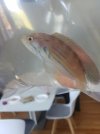Hi everyone,
For clarification:
Yes, the QT that we do always includes drug treatment unconditionally on every single fish. Some people might choose to isolate only, and that is still a quarantine without treatment, and it still has its benefits; but generally in the industry "quarantined fish" means that it includes drug treatment. As a link above provided, I wrote a brief overview of the process I do at the new shop. I should still do a better writeup. Yes, every single tank gets bleached in between additions or when doing a tank transfer. The former system at the old store also had individual isolation and plumbing, but the water was shared, and drugged, and we used massive amounts of UV and ozone.
Why:
Up to 90% of fish caught wildly have velvet and many other parasites on it (Uronema marinum, etc). It depends on the season and exactly where caught, but that's expected, it's the ocean and these parasites come from the ocean. The true problem is the aquarium systems both at the collection and wholesaler level. The sad reality is most fish caught don't ever make it to an aquarium store at all. Many go through multiple wholesalers in foreign countries where they are aggregated and bought and resold, and die. These systems often are not very advanced and may not use much medication. It then goes through the importer, generally a wholesaler that wants to move the fish as quickly as possible, and has fish coming in and out of the systems often. Only the strongest make it through. What has actually proliferated significantly, especially in the last 2 years is copper resistant velvet (Amyloodinium). There are many different strains of velvet, like all organisms, regional differences and genetic variability occur. Some have adapted to constant exposure to copper, of either excessively low or high concentrations over extended periods of time. You'd assume high concentrations would be totally lethal, but what actually happens is the partial exposure and "treatment" time (days) is insufficient to complete the lifecycle. New additions keep coming in constantly; low levels of copper may not be sufficient for complete eradication fast enough, and for systems kept at very high copper levels constantly, 99% may get eradicated, but the tiniest bit that do survive end up reproducing - very slowly - with much resistance to copper, and normal dosages of copper used in the past are no longer very effective. This same phenomena occurs with antibiotics and produces resistance. UV sterilization at the commercial level kills the vast majority of what flows through it, but some persists on the fish and in the water that doesn't make it into the UV. While under control of UV and slow growing velvet, the fish create antibodies and develop strong resistance to velvet, along with many other external protozoa. This may manifest itself as a fish that eats and appears fine, perhaps with the tiniest of fin erosion if you look super carefully, or muted coloration, but it will gradually become overwhelmed with velvet that can take a long time to kill. The fish can then be put into a tank with fish free of disease, free of medication, and fish not accustomed to parasites, which will then rapidly proliferate on those fish and spread to everyone and cause big losses. Some fish can maintain suitable levels of resistance for months, or even longer, and until an event occurs causing immunosuppression, or a UV sterilizer breaks, it's kept under control. I get a customer coming in to me several times a month with this occurring.
How do I know all this?
I happen to have long had a keen interest in microbial pathogenesis. I received a BS in Microbiology from the University of Hawaii - spending a lot of time with marine fish as a hobbyist, and scuba diving constantly, rarely collecting myself. Prior to opening a fish store in Oakland, I was a Sr Molecular R&D Engineer here in the Bay working on PCR (which everybody knows about now, thanks to COVID) for various human bacterial and viral diseases. I very much continue to learn about ichthyology and I maintain and check out the fish in my microscope here. While I don't dissect each and every fish that dies, or examine everything before sale [It's hard enough trying to get even $20 more for a fish] I regularly examine skin scrapings, fin snips, examine waste, and see what may have caused some mortality if I am not sure.
Many times fish die and it isn't because of anything pathogenic. They can succumb to so many issues - even lactic acid and cortisol from stress just being caught by a net can overwhelm a fish; osmoregulation difficulties, hypoxia from gill inflammation combined with reducers that remove oxygen, even in "aerated" water, etc. Like every living organism, they're very, very complex.
My focus in owning a fish shop has long been towards making new innovations in aquatic treatment. On the side, I am working on various experimental treatments and drugs; one day I'll have new medications out there with delivery mechanisms that can work in a reef tank but also make it out to the collector site in an effort to reduce fish mortality. It takes time. Most of our regular customers are aware that supporting our store goes to those initiatives.
I will never guarantee any fish to truly be free from disease, but can do absolute best practices to making it as healthy as possible given the realities of cost. It is hard enough to sometimes sell fish for $20 more than another shop, even with costs to treat it exceeding that. We still have to pay rent and employees and do more than 1 fish at a time. Anyone selling fish, or quarantining and telling you a fish is disease free, does not have a complete understanding of the complexity and variety of pathogenic organisms that could come along with the fish, and the many other problems a fish may be suffering from that is impossible to detection by visual or observational means of any kind. More often than not, fish suffer ammonia damage from acclimation that doesn't manifest itself for weeks. I will be doing a write up about that at some point. In the future, we will have genomic sequencing and PCR analysis to identify fish pathogens. Even then, however, something pathogenic could still slip through during bagging with a cross contamination event The best that can be done is continued risk reduction and improving the health of the fish to the highest possible level. Healthy fish that have been well adjusted can heal themselves from a wide variety of issues.


